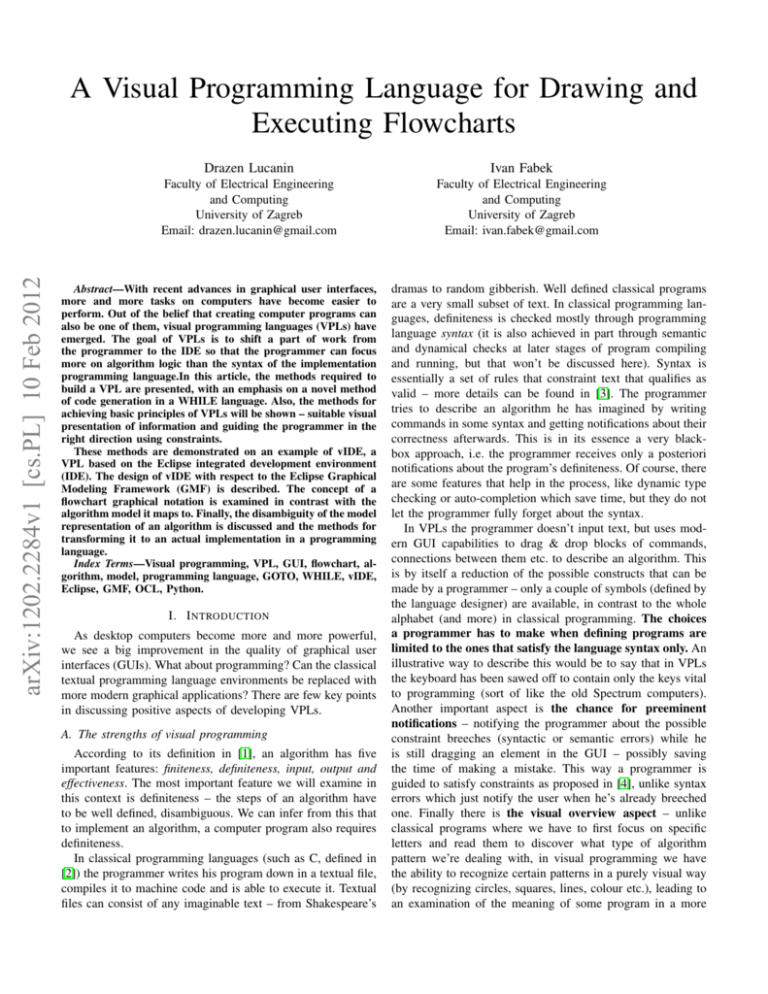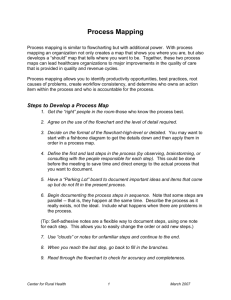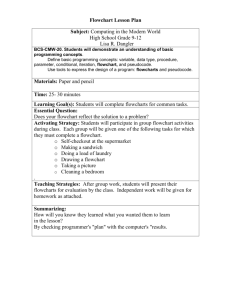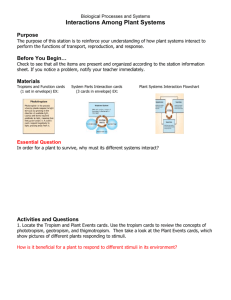
arXiv:1202.2284v1 [cs.PL] 10 Feb 2012
A Visual Programming Language for Drawing and
Executing Flowcharts
Drazen Lucanin
Ivan Fabek
Faculty of Electrical Engineering
and Computing
University of Zagreb
Email: drazen.lucanin@gmail.com
Faculty of Electrical Engineering
and Computing
University of Zagreb
Email: ivan.fabek@gmail.com
Abstract—With recent advances in graphical user interfaces,
more and more tasks on computers have become easier to
perform. Out of the belief that creating computer programs can
also be one of them, visual programming languages (VPLs) have
emerged. The goal of VPLs is to shift a part of work from
the programmer to the IDE so that the programmer can focus
more on algorithm logic than the syntax of the implementation
programming language.In this article, the methods required to
build a VPL are presented, with an emphasis on a novel method
of code generation in a WHILE language. Also, the methods for
achieving basic principles of VPLs will be shown – suitable visual
presentation of information and guiding the programmer in the
right direction using constraints.
These methods are demonstrated on an example of vIDE, a
VPL based on the Eclipse integrated development environment
(IDE). The design of vIDE with respect to the Eclipse Graphical
Modeling Framework (GMF) is described. The concept of a
flowchart graphical notation is examined in contrast with the
algorithm model it maps to. Finally, the disambiguity of the model
representation of an algorithm is discussed and the methods for
transforming it to an actual implementation in a programming
language.
Index Terms—Visual programming, VPL, GUI, flowchart, algorithm, model, programming language, GOTO, WHILE, vIDE,
Eclipse, GMF, OCL, Python.
I. I NTRODUCTION
As desktop computers become more and more powerful,
we see a big improvement in the quality of graphical user
interfaces (GUIs). What about programming? Can the classical
textual programming language environments be replaced with
more modern graphical applications? There are few key points
in discussing positive aspects of developing VPLs.
A. The strengths of visual programming
According to its definition in [1], an algorithm has five
important features: finiteness, definiteness, input, output and
effectiveness. The most important feature we will examine in
this context is definiteness – the steps of an algorithm have
to be well defined, disambiguous. We can infer from this that
to implement an algorithm, a computer program also requires
definiteness.
In classical programming languages (such as C, defined in
[2]) the programmer writes his program down in a textual file,
compiles it to machine code and is able to execute it. Textual
files can consist of any imaginable text – from Shakespeare’s
dramas to random gibberish. Well defined classical programs
are a very small subset of text. In classical programming languages, definiteness is checked mostly through programming
language syntax (it is also achieved in part through semantic
and dynamical checks at later stages of program compiling
and running, but that won’t be discussed here). Syntax is
essentially a set of rules that constraint text that qualifies as
valid – more details can be found in [3]. The programmer
tries to describe an algorithm he has imagined by writing
commands in some syntax and getting notifications about their
correctness afterwards. This is in its essence a very blackbox approach, i.e. the programmer receives only a posteriori
notifications about the program’s definiteness. Of course, there
are some features that help in the process, like dynamic type
checking or auto-completion which save time, but they do not
let the programmer fully forget about the syntax.
In VPLs the programmer doesn’t input text, but uses modern GUI capabilities to drag & drop blocks of commands,
connections between them etc. to describe an algorithm. This
is by itself a reduction of the possible constructs that can be
made by a programmer – only a couple of symbols (defined by
the language designer) are available, in contrast to the whole
alphabet (and more) in classical programming. The choices
a programmer has to make when defining programs are
limited to the ones that satisfy the language syntax only. An
illustrative way to describe this would be to say that in VPLs
the keyboard has been sawed off to contain only the keys vital
to programming (sort of like the old Spectrum computers).
Another important aspect is the chance for preeminent
notifications – notifying the programmer about the possible
constraint breeches (syntactic or semantic errors) while he
is still dragging an element in the GUI – possibly saving
the time of making a mistake. This way a programmer is
guided to satisfy constraints as proposed in [4], unlike syntax
errors which just notify the user when he’s already breeched
one. Finally there is the visual overview aspect – unlike
classical programs where we have to first focus on specific
letters and read them to discover what type of algorithm
pattern we’re dealing with, in visual programming we have
the ability to recognize certain patterns in a purely visual way
(by recognizing circles, squares, lines, colour etc.), leading to
an examination of the meaning of some program in a more
Fig. 1.
A diagram showing the distribution of work between the programmer and the IDE in visual programming
top-down manner.
All in all, an attempt is made in VPLs to shift more of the
work from the programmer to the IDE. As illustrated in
Fig. 1, the task of syntax generation is done automatically –
allowing the programmer to focus more on the abstract notions
of algorithm design.
To summarize, the benefits of this shift are:
• easy syntax rule obeying – only the freedom of creating
programs is given to the programmer
• a better notification system – due to the fact that the
IDE has more knowledge about the program and the
programmer’s actions at an earlier moment than classical
programming IDE
• visual representation can be easier to grasp
B. Related work
In [4] a general overview of the visual programming
strengths and weaknesses is examined with a lot of examples
of how certain languages cope with these opportunities and
challenges. The two most notable items proposed are:
• static representation – is a graphical notation used to
present a program at rest sufficient to understand the logic
• effective use of computer display – showing only the
information important to the user at any given time
LabView and Simulink can be mentioned as the representatives of a big group – the data flow VPLs, described in [5],
which are based around a functional programming style. A
similar VPL, but presented as an online web service is Yahoo
Pipes [6].
KTechlab [7] is a flowchart VPL used to describe hardware
components. Scratch [8] is a good example of a WHILE
language flowchart VPL that has taken the role of education
through fun and interactive app programming. One drawback
in Scratch is that it doesn’t present the user with the source
code generated from his flowchart, thus not encouraging
gradual transition to classical programming as the user gets
more experienced.
C. Goals
The goal of this paper is to present the methods required
to create a VPL for editing and executing flowcharts with an
additional ability to generate classical source code from them.
This would give the user another educational step between
Scratch and classical programming, where he would be able
to draw a flowchart and generate good quality, readable code
from it and execute it. The code readability would let him
study and understand the syntax created from his flowcharts.
These methods will be explained on an example of vIDE,
a VPL that was built to fulfil the requirements. The motive
behind vIDE is to lower the barrier of learning programming
for children as well as for other experts who don’t know a
programming language syntax, but need to implement certain
algorithms.
Firstly, a flowchart editor is needed and the problem of
synchronizing a graphical representation with a model will be
addressed. Secondly, we will cover the problem of generating
code in a certain classical programming language from this
model.
An interesting aspect of code generation that will be explored is the internal representation of an algorithm in a
GOTO manner, the most similar in logic to a flowchart, and
its transformation to a WHILE language data structure. The
GOTO and the WHILE languages are formally defined in [9].
In short – the GOTO language uses a GOTO instruction to
jump anywhere in the program, while the WHILE language
has WHILE and IF instructions to conditionally execute a
certain block (zero, one or multiple times) thus adding more
structure and making the flow more predictable. It will be
shown that the transformation from a GOTO language to a
WHILE language representation is a very practical way of
building a flowchart VPL because of the difference between a
VPL conceptual model and an output classical programming
language.
D. Organisation of the paper
In section II the methods used to create a VPL are presented.
In II-A a system architecture of vIDE will be explained so
that certain modules can be referenced later in a more clear
way. The problem of diagram-to-model mapping is discussed
in II-B. The motives and mechanics behind GOTO-to-WHILE
model-to-model transformation used in vIDE is given in II-C.
Finally, the last step of generating code is shortly explained
in II-D.
In section III we examine the capabilities of vIDE – a simple
example of usage, the special cases of constraint satisfaction
and a useful feature of knowledge inferring from the model.
Section IV places the achieved results in the context of
related work and the initial objectives and summarizes the
Fig. 2.
A graphical overview of the vIDE system architecture
advantages of the used techniques and possible improvements.
B. The flowchart editor – mapping a diagram to a model
II. M ETHODS
In order to be fully usable as a programming language, a
VPL must allow the programmer to:
• express an algorithm’s logic in some manner and
• be able to translate this logic into executable machine
instructions
Next, the methods used in implementing our VPL, vIDE,
to achieve this will be analyzed.
In every VPL some sort of diagram editor is needed that
can be map a graphical notation to a model. A flowchart editor
in vIDE was created using GMF, which uses a nice abstract
way of describing the diagram editor. In this part it doesn’t
really matter what sort of a diagram we’re building (flowcharts
are just special types of diagrams). The way GMF works
is that it requires several models which define the diagram
editor’s behaviour. Using these models, the diagram editor
Eclipse plug-in can then be generated. Methods for building
the flowchart editor will be given here in relation to the GMF
architecture, but these or similar modules would be required
when creating a diagram editor utilizing any other technology
as well.
The models needed to create a diagram editor, that is, their
implementations for vIDE through GMF are:
• A graphical definition – describing the graphical elements that the user will see in his diagram; in vIDE that
would be the block, branch and connection elements.
• A tooling definition – definitions of available tools for
drawing the diagram; one tool is defined in vIDE for
every graphical element.
• An Eclipse Modelling Framework (EMF) model – this
is basically the goal data structure synchronized with the
diagram as the user edits it; in vIDE a simple GOTO-like
algorithm data structure is used and its class diagram can
be seen in Fig. 3.
• A mapping model – this is the heart of the diagram
editor description, it defines how to map elements from
the graphical definition to an EMF model and GMF
uses this definition to synchronize the diagram and the
model automatically; if an algorithm model uses a GOTO
representation (as is the case in vIDE), this mapping is
pretty straightforward – a block element maps to a block
class, branch to branch etc.
A. System Architecture
The system architecture of vIDE, the VPL used as an
example VPL in this paper, is illustrated in Fig. 2.
In a very general sense vIDE achieves the basic programming language functions through:
• a flowchart editor – where the programmer visually
defines his logic
• a launcher (a compiler of sorts) – which transforms the
user’s flowchart into source code that can be executed
The first step to achieve this is to allow the user to
draw a flowchart. This was implemented using the GMF, a
framework for creating diagram editors. As seen in Fig. 2,
an algorithm model is kept in sync with the flowchart that
the user draws. GMF does this automatically according to a
predefined mapping model). Further information about GMF
can be found in [10].
The flowchart can be launched through the GUI when the
user is happy with it. This action initiates a transformation
of the algorithm model represented in a GOTO manner to
an equivalent WHILE language style representation (this is
required because a WHILE representation can’t be created by
GMF directly from the vIDE flowchart graphical notation –
this will be further discussed in section II-C).
From the WHILE language data structure, a concrete textual
syntax can easily generate code in any programming language
that relies on WHILE and IF commands to control data flow
(for example C [2] or Python [11]). In vIDE, a Python syntaxer
module is called to generate a Python script as the output
program, equivalent to the user’s flowchart.
Once the output program is generated, the user can study
the source code to learn its syntax or simply run it and observe
the effects of the flowchart he drew.
In the next few sections the vital methods needed to create
a VPL able to generate code will be examined using vIDE as
an example implementation.
C. An algorithm for GOTO to WHILE transformation
After an algorithm model has been created, a program
could be generated disambiguously. The problem is that the
algorithm model is described in a GOTO language manner
and we want to generate a program in a WHILE language.
To achieve this, a transformation is necessary. First, we will
examine the motives for organizing the data structures in
such way that the transformation is necessary and then the
transformation algorithm itself.
Fig. 3. Algorithm EMF model used in vIDE - a GOTO-like data structure
generated from the flowchart
1) Reasons for using a GOTO language: For a representation of algorithms in flowcharts, a GOTO language seems
more natural, because of a single connection (or we might say
flow) going out of every block.
Other possible graphical representations were explored with special graphical elements for WHILE and IF commands,
but these approaches were dropped, because there would have
to be multiple outgoing flows and additional explanation of
these elements’ behaviour would be necessary, which would
complicate the usage of vIDE.
2) Reasons for NOT using a GOTO language: It was
explained in the last subsection that GOTO is a suitable
language for the graphical representation of an algorithm. For
the generated programs, on the other hand, WHILE-languages
should generally be used instead.
In his open letter, Dijkstra expressed his opinion against
using GOTO instructions in programming [12], while Knuth
said in [13] that they can be useful at times. Generally, we
can conclude that GOTO commands can be used carefully
(an example of proper usage of GOTO commands in modern languages are exceptions), but WHILE, IF and similar
commands should be used to create structured programs.
Structured programs are defined in [13].
One of the good sides of structured programming is readability – if a programmer wants to see what was generated
from his flowchart, it would be much more readable (not to
mention educational) if loops would be interpreted as WHILE
commands and normal branches as IF commands (instead of
everything mapping to simple GOTO commands).
A WHILE language representation of the flowchart might
be useful to have in a data structure for visual purposes as well,
because the usage of structured programming would allow
features such as graph folding (letting the programmer hide
unnecessary nodes manually or let the IDE do it for him using
context-aware technologies such as [14]).
Python was chosen for an output programming language in
vIDE because of its simplicity and readability, so another prac-
tical reason for not generating code using GOTO commands in
vIDE in specific is that Python doesn’t have a GOTO command
in its language.
3) Combining the two - the constrained GOTO: When a
pure GOTO language representation of an algorithm is stored
in a data structure it is clearly a graph – it can contain loops to
already executed commands. When an algorithm represented
in a structured WHILE programming language is stored it is
possible to represent it by a tree – an intuitive example of
this is the ability to fold code in environments such as Eclipse
[15]. The reason this is possible is that the body of a WHILE
loop or an IF body can’t jump to any other instruction outside
its parent WHILE/IF instruction. Even though it’s possible to
model WHILEs and IFs using GOTO commands, the GOTO
would also allow “forbidden jumps” (for example to the same
command), therefore necessitating a graph data structure for
the algorithm’s representation.
Since graphs can’t generally be represented by trees, to
be able to transform a GOTO representation to a WHILE
representation, constraints have been introduced in vIDE on
the flowcharts that can be drawn in it:
•
•
loops can only be drawn to go back to the last branch
predecessor (of the same branching depth)
if a branch is not a loop its children blocks must join at
one point (they need to share a common successor) on
the same branching depth
Using these two constraints we effectively mask a WHILE
language using a GOTO language, without the fear of not
being able to convert it to a tree representation.
4) The transformation algorithm: Once we set the constraints, we can define an algorithm for transforming a constrained GOTO algorithm (illustrated in Fig. 3) into a WHILE
algorithm.
The GOTO-to-WHILE algorithm is essentially a depth first
search (DFS) that recursively processes the nodes of a GOTO
algorithm collecting single instructions to blocks and translating branches to WHILE or IF commands using processed
node “colouring” (see [16] for DFS and similar graph traversal
algorithms).
This is the basic idea of the algorithm (meant to be called as
G2W(instruction), where the first instruction of the main block
of the algorithm should be provided to the initial function call):
while instruction exists do
if instruction’s a block then
nothing special
end if
if instruction’s a branch then
trueChild ← true child of the branch
if G2W(trueChild) found processed command then
translate instruction to WHILE
end if
if G2W(trueChild) reached program end then
translate instruction to IF
end if
end if
and used to draw flowcharts and generate Python code from
them. In this section its capabilities will be examined.
A. An example of vIDE usage – code generation
The example of the Euclid’s algorithm drawn as a flowchart
in vIDE is shown in Fig. 4. From this flowchart the user can
launch the code generation and a Python script is generated,
equivalent to the algorithm defined in the flowchart:
Fig. 4.
A flowchart of the Euclid’s algorithm drawn in vIDE
mark instruction processed
instruction ← next instruction
end while
Note that G2W(trueChild) represents processing child instructions of a branch in the case of the condition being met –
going further in depth recursively on the true side. Also, this
is only a sketch of the “interesting” parts of the algorithm. In
an actual implementation:
• All the constraints need to be checked and any breeches
communicated to the user.
• Also, resolving the IF transformation is a bit more
complex and requires tracing the condition being false
branch as well and fixing the tree afterwards (because
at first all the successor instructions would be added to
IF as children – an intersection, i.e. the end of the IF
instruction, can only be found after tracing the second
branch – false).
• The last omitted aspect is the communication – a lot of
information needs to be passed as arguments to recursive
function calls or using a stack to identify the true state
of the graph.
These details were skipped, since they would complicate the
pseudo-code a lot and they can be implemented quite routinely.
D. Model-to-code transformation
After we have the algorithm represented in a tree-like
structure of a structured WHILE language, the code generation
is very simple and consists of:
1) a DFS through the tree
2) translating instruction objects to strings in the goal
language syntax (Python in vIDE’s example) on a oneto-one mapping basis.
III. R ESULTS
As a result of implementing all the presented methods, vIDE
was built – a VPL that can be installed as an Eclipse plug-in
m=6
n=2
r = m
while
m
n
r
print
print
% n
r != 0 :
= n
= r
= m% n
" G r e a t e s t common d i v i s o r i s : "
n
The branch in the flowchart was recognized by the GOTOto-WHILE transformation algorithm to be a loop (because
an instruction was pointing to its predecessor; note that a
constraint wasn’t breeched because it is the last branch) so
a WHILE instruction in Python was generated.
B. Constraint satisfaction in vIDE
An example of automatic constraint satisfaction checking is
implemented in vIDE, so that the user is not allowed to make
a mistake in the first place. For example the user can’t connect
a block to itself (a circular connection - it would result in an
infinite loop), because the environment won’t let him “drop”
a connection on that position. This was implemented using
the Object Constraint Language (OCL) [17], a language for
constraint definition which is integrated with GMF in a way
that the checks are done in real time – presenting the user
with the currently relevant information.
The constraints defined in section II-C3) will notify the user
about a constraint breech only when he launches the flowchartto-code transformation. This wasn’t implemented in OCL, but
in Java (because the check requires recursive function calls,
which to our knowledge isn’t possible in OCL), as a part of the
GOTO-to-WHILE transformation, so the notifications aren’t
real-time.
C. Knowledge inferring in vIDE
One of the nice features of GMF is that it infers knowledge
from the EMF model created to describe the diagram editor.
An example in vIDE is that creating a connection from a
branch for the first time asks the user whether it is the true
or the false case, but when a true case is already present, the
system deduces that there is no need in show this choice to
the user as seen in Figure 5, resulting in only the semantically
relevant information presented.
ACKNOWLEDGEMENTS
The authors whish to express their gratitude to Professor
Domagoj Jakobović, doc.dr.sc. at the Faculty of Electrical Engineering and Computing, University of Zagreb, for mentoring
this research and his help in writing the paper.
R EFERENCES
Fig. 5.
Connection creation wth deduction (excess choices are trimmed)
IV. C ONCLUSION
The proposed methods for building a VPL capable of
flowchart editing and code generation have been shown to
work on the example of vIDE. The VPL can be used for
drawing and executing flowcharts comparable to [8], while
also giving the user the novel ability of generating clear,
readable Python code, achieving the goals set in I-C. This
is important, because it allows the users to more easily grasp
programming language syntax and move to more complex,
classical programming later (if needed). Such an application
could find a lot of use in lowering the programming entry
barrier and would be important for:
• didactic purposes – teaching programming in an interactive and visual way
• ease of usage – making programming more accessible to
people of other professions
Features such as knowledge inferring, described in III-C,
provide a great way of leveraging advanced GUI capabilities
to provide a better programming environment. This goes in
line with the general guidelines for creating VPLs stated in [4]
and could be considered as a visual programming equivalent
of context aware systems such as Mylyn [14].
Constraint definition using OCL enables real-time notifications. This seems to be a good way to utilize the advantages
of VPLs – namely a chance for preeminent notifications,
as described in I-A. One of the problems is checking more
complex constraints. Perhaps iterative transformation to the
WHILE language model while the flowchart is being drawn
would allow for more lively notifications.
[1] D. Knuth, Art of Computer Programming, Volume 1:
Fundamental Algorithms. Addison-Wesley Professional, Jul. 1997.
[Online]. Available: http://www.amazon.ca/exec/obidos/redirect?tag=
citeulike09-20&path=ASIN/0201896834
[2] B. Kernighan and D. Ritchie, C Programming Language (2nd Edition).
Prentice Hall, Apr. 1988. [Online]. Available: http://www.amazon.ca/
exec/obidos/redirect?tag=citeulike09-20&path=ASIN/0131103628
[3] J. Hopcroft, R. Motwani, and J. Ullman, Introduction to automata
theory, languages, and computation. Pearson/Addison Wesley, 2007.
[Online]. Available: http://www.worldcat.org/oclc/318405933
[4] I. Burnett, M. Baker, C. Bohus, P. Carlson, S. Yang, and P. V.
Zee, “Scaling up visual programming languages,” Computer,
vol. 28, no. 3, pp. 45–54, 1995. [Online]. Available:
http://ieeexplore.ieee.org/Xplore/login.jsp?reload=true&url=http:
//ieeexplore.ieee.org/iel1/2/8390/00366157.pdf%3Farnumber%
3D366157&authDecision=-203
[5] W. Johnston, P. Hanna, and R. Millar, “Advances in dataflow
programming languages,” ACM Comput. Surv., vol. 36, no. 1, pp. 1–
34, Mar. 2004. [Online]. Available: http://dx.doi.org/10.1145/1013208.
1013209
[6] T. Loton, Working with Yahoo! Pipes, No Programming Required.
Lotontech Limited, Feb. 2008. [Online]. Available: http://www.amazon.
ca/exec/obidos/redirect?tag=citeulike09-20&path=ASIN/0955676444
[7] “KTechlab,” http://sourceforge.net/projects/ktechlab/. [Online]. Available: http://sourceforge.net/projects/ktechlab/
[8] “Scratch,” http://scratch.mit.edu/. [Online]. Available: http://scratch.mit.
edu/
[9] A. Saabas and T. Uustalu, “A compositional natural semantics and hoare
logic for low-level languages,” Electronic Notes in Theoretical Computer
Science, vol. 156, no. 1, p. 151–168, 2006.
[10] R. C. Gronback, Eclipse Modeling Project: A Domain-Specific Language
(DSL) Toolkit, 1st ed. Addison-Wesley Professional, Mar. 2009.
[11] “Python
programming
language
–
official
website,”
http://www.python.org/. [Online]. Available: http://www.python.org/
[12] E. Dijkstra, “Go to statement considered harmful.” Upper Saddle River,
NJ, USA: Yourdon Press, 1979, p. 27–33, ACM ID: 1241518. [Online].
Available: http://portal.acm.org/citation.cfm?id=1241515.1241518
[13] D. E. Knuth, “Structured programming with go to statements,” ACM
Computing Surveys (CSUR), vol. 6, p. 261–301, Dec. 1974, ACM ID:
356640.
[14] “Mylyn,” http://tasktop.com/mylyn/. [Online]. Available: http://tasktop.
com/mylyn/
[15] “Folding in eclipse text editors,” http://www.eclipse.org/articles/ArticleFolding-in-Eclipse-Text-Editors/folding.html.
[Online].
Available:
http://www.eclipse.org/articles/Article-Folding-in-Eclipse-Text-Editors/
folding.html
[16] T. H. Cormen, C. E. Leiserson, R. L. Rivest, and C. Stein, Introduction
to Algorithms, Third Edition, 3rd ed. The MIT Press, Sep. 2009.
[17] “Object constraint language - wikipedia, the free encyclopedia,” http://en.wikipedia.org/wiki/Object_Constraint_Language.
[Online]. Available: http://en.wikipedia.org/wiki/Object_Constraint_
Language








